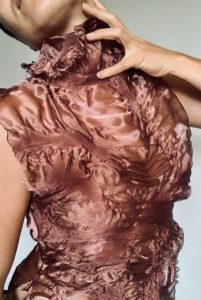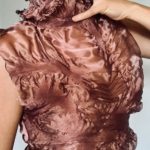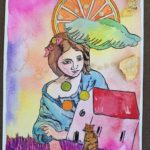Unravelling
Impressions of Unravelling
Danielle Fagen, dress from Unravelling (Never Apart Gallery, forthcoming 2021). Image courtesy of the artist.
In her upcoming show Unravelling, Montreal-based fashion and costume designer Danielle Fagen blurs the lines between body and fabric, dream and reality, sight and seer, vision and touch, affect and cognition – or, perhaps, demonstrates how unstable such divisions have always been. Unravelling incorporates dance (featuring dancer Alisa Pobega), photography (Damian Siquieros), and poetry (full disclosure – myself), and centers around a series of garments created by Fagen. These seven dresses explore states of anxiety, particularly in the context of insomnia and nightmares, as not only altered mental states or clinical diagnoses but embodied ways of being – relationships to our own and others’ bodies, inextricable from the layers of culture and history that shape how we move through the world.
In today’s clinical – and increasingly, popular – parlance, anxiety disorders tend to be conceptualized as brain-based phenomena. Clinicians and the general public often speak of these conditions as chemical imbalances or as abnormalities in neurological structure. More nuanced conceptions draw on theories of neuroplasticity, addressing how lived experiences guide the brain’s development. But, as Fagen’s work demonstrates, anxiety is not limited to the brain: it is experienced in bodies, and in the space between bodies. The felt immediacy of anxiety calls into question any framework that positions the thinking, rational brain as separable from (and dominant over) the feeling, emotional body. In anxiety, thoughts loop and race, seeming to pulse in our veins as physical presences. Moreover, in witnessing anxious bodies, we may share in their discomfort; our skin might “crawl.” In these situations, we are often compelled, however unconsciously, to squirm, as though to physically distance the porous boundary of our skin from affects, sensations, and even thoughts that threaten to leak into us. In The Cultural Politics of Emotion, Sara Ahmed writes that “[E]motions work to shape the ‘surfaces’ of individual and collective bodies. Bodies take the shape of the very contact they have with objects and others” (2004: 1). These “surfaces” and this “contact” are not simply metaphorical – we know the world through bodily sensoriums that can never exist outside of histories and relations. For this reason, Ahmed rejects an artificial distinction between cognition, affect, and sensation, instead using the term “impression,” which evokes these concepts simultaneously: an impression is a belief, an affective atmosphere, and a physical change one surface causes in another.
Fagen’s work gives a powerful sense of how these interweave. In the above dress, she has used burnt organza to bring the impressions of anxiety to the surface of the skin. The curiously organic-looking garment is what Eve Sedgwick might term “biomorphically resonant,” evoking associations with the viewer’s own corporeality (2003: 22). As we come into contact with the dress through our senses – not only sight, but the interoceptive, proprioceptive, and tactile sensations stirred when one body perceives another – the resonances that move through and under our skin are far from comfortable. The shiny, bunched-up fabric combines with its flesh-like tone to place this dress in the uncanny valley – organic enough to immediately evoke a sense of the human form, but different enough to feel disconcertingly “off” even as we appreciate its fine craft. The fabric clings to the dancer’s skin, seeming to draw the viewer into intimate proximity – we may imagine the delicate touch of the gauzy fabric, the sensation of crinkling that accompanies her/our movements. Yet, as the fabric bubbles and clenches, it also creates ambiguity about the shape of the body beneath, giving an uneasy dimension to this intimacy: as though the dancer’s anxious skin has begun, literally, to crawl.
It is worth noting that anxiety, like design and fabric arts, tends to be stereotyped as feminine – as, of course, are dresses. Anxiety disorders, primarily diagnosed in women, are simultaneously feminized and pathologized: a Western cultural trope of “one way to be a woman,” yet nonetheless an “incorrect” way. Fagen toys with these tricky binds of gendered expectations, teasing them to the surface; while women’s fashion is often beautiful to the viewer yet uncomfortable to the wearer, this dress stirs discomfort in witnesses’ own skin. Organza, a lightweight, sheer material, would seem through its gauzy transparency to evoke the airy, unearthly ideal of “dreaminess” associated with femininity. However, in her choice to use heat to shape the material, Fagen has caused the fabric itself to squirm, suggesting that femininity might not be such a disembodied, ethereal space to occupy – that it can, at times, be deeply uncomfortable, and that we remain marked by impressions of this discomfort. As the dress shimmers and simmers beneath the lights, we may appreciate its beauty while also flinching as we empathize, however involuntarily, with the sense of skin being pinched or distorted. These unsettling sensations may even appear in our own bodies; challenging conventional assumptions of a disembodied, objective, and implicitly male viewer, Fagen brings us into the blurred space of a dream in which identities merge, in which we are simultaneously ourselves and another.
Unravelling unfolds in the disorienting liminal states between insomnia and anxiety-dreams, the space in the night in which the boundaries of our own thoughts, and even of our bodies, are simultaneously painfully palpable and unbound into a shapeless, shifting dark. The creases in the dress resemble the indents left in skin after these restless nights, the moment one greets the morning wrapped in sweat-damp sheets, marked with impressions in every sense of the word. Though the marks fade quickly, their traces remain. We feel it.
Madelaine Caritas Longman
Concordia University, Montreal, Canada
Works Cited
Ahmed, Sara. 2004. The Cultural Politics of Emotions. Edinburgh: Edinburgh University Press.
Sedgwick, Eve Kosofsky. 2003. Touching Feeling. Durkham and London: Duke University Press.
Works Consulted
Martin, Daria (ed.). 2018. Mirror-Touch Synaesthesia: Thresholds of Empathy with Art. Oxford: Oxford University Press.
Parker, Rozsika. 1984. The Subversive Stitch: Embroidery and the Making of the Feminine. London: Bloomsbury.


